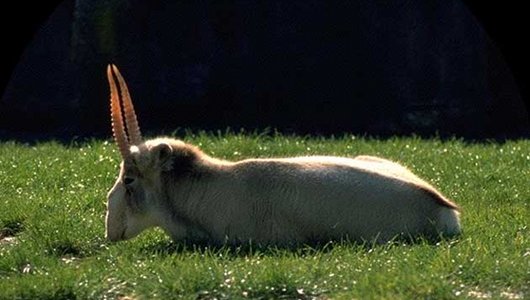
Nearly 12,000 critically endangered saiga antelope have been found dead within a 17 square-mile area of the Ural region of western Kazakhstan, according to the World Wildlife Fund. The cause of the mysterious mass loss is still unclear, though initial investigators believed the animals may have been poisoned.
"This is a tragic and shocking event. It's particularly unfortunate that the population was just emerging from an unusually harsh winter, and that those struck down are mostly females and this year's calves," said professor E.J. Milner-Gulland, chair of the Saiga Conservation Alliance.
The event is being called a conservation catastrophe, as the losses amount to a nearly 50 percent drop in population for the Ural group and a 15 percent drop for the entire species in Kazakhstan. Listed as critically endangered on the IUCN Red List, the saiga population as a whole has declined by 95 percent since 1995.
Though the animals once roamed widely throughout the Eurasian steppe zone and even as far as the British Isles to the west and Alaska and the Yukon to the east, only five populations of the antelope still remain - in Russia, Kazakhstan, Uzbekistan and Mongolia.
Reports indicate that the immediate cause of the deaths is due to an outbreak of the bacterial infection known as pasteurellosis, but the underlying cause of the epidemic is still unidentified. The pasteurella bacterium occurs naturally and is typically benign in healthy antelope, and it only becomes deadly when the animal's immune system is compromised because of stress, malnutrition or even poisoning.
To prevent further outbreak, veterinarians and emergency officials are reportedly burning the carcasses and organizing immediate quarantine measures, hoping to keep the population from crashing entirely.
Prior to this event, the biggest threat to the animals has come from uncontrolled poaching in the aftermath of the break-up of the Soviet Union. They are prized by poachers due to their horns, which are increasingly used in unfounded traditional Chinese medicine as an alternative to the rhinoceros horn.
The unique-looking saiga antelope are perhaps best recognized by their extremely unusual, over-sized, bulbous and flexible nose structure, which they use to filter out dust. They can be an important species within the ecosystems they occupy since they eat many plants that are poisonous to other animals.
"The Ural population has been relatively neglected by international conservation until now, but hopefully this event will bring government, national and international conservationists together to mount a coordinated response to save this remote population," said Milner-Gulland.



A biological testing ground?